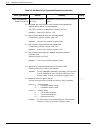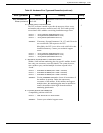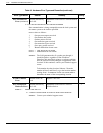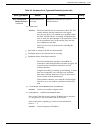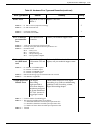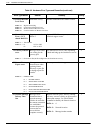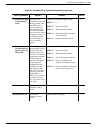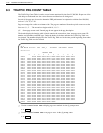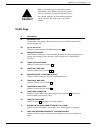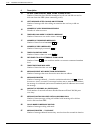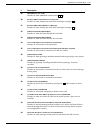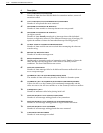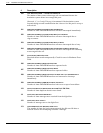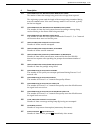
8-40 Installation and Maintenance Volume
Octel 200/300 S.4.1 PB60019−01
8.3 TRAFFIC PEG COUNT TABLE
The Traffic Peg Count Table is used to record events monitored by the OctelR 200/300. Proper use of the
table helps to understand how the various features and functions are being used.
Several of the pegs may be used to determine PBX performance in conjunction with the Octel 200/300,
such as 13, 24, 25, 47−49.
Pegs are arranged in a table ten columns wide. The pegs are numbered from the top left corner across the
first row 0, 1, 2. . . The second row begins with 10, 11, 12 . . .
. Some pegs are not used. Unused pegs do not appear in the peg description.
The header displayed when the table is listed contains the current date, time, message server name, ID
number, serial number, and PBX type. Under the header is the date and time the Traffic Peg Table was
last cleared. The numbers displayed in the Traffic Peg Table are for the time period beginning from when
the Traffic Peg Table was last cleared.
@L P
MON MM/DD 10:43:20 YYYY V200_4 ID:200444 S/N:200003 PBX:63
05/16 14:11
TRAFFIC PEGS
0 1 23456789
00000 00078 00000 00020 00013 00000 00000 00001 00004 00056
00010 00022 00000 00005 10063 00000 07976 00009 00001 00002 00000
00020 00000 00000 00002 00009 65535 00000 00000 00001 00000 00000
00030 00008 00000 00023 00006 00000 00002 00002 00001 00001 00003
00040 00000 00000 00000 00000 00000 00010 00002 00000 00004 00000
00050 00000 00000 00000 00000 00000 00000 00000 00000 00000 00000
00060 00000 00000 00000 00000 00000 00000 00000 00000 00000 00000
00070 00000 00000 00000 00000 00002 00000 00000 00000 00000 00000
00080 00000 00000 00000 00000 00000 00000 00000 00000 00000 00000
00090 00000 00000 00000 00000 00000 00000 00000 00000 00000 00000
00100 00000 00000 00000 00000 00000 00000 00000 00000 00000 00000
00110 00000 00000 00000 00000 00000 00000 00000 00000 00000 00000
00120 00000 00000 00000 00000 00000 00000 00000 00000 00000 00004
00130 00000 00061 00018 00000 00000 00000 00000 00000 00004 00000
00140 00001 00000 00001 00000 00002 00004 00001 00000 00000 00000
00150 00000 00000 00000 00000 00000 00000 00000 00000 00000 00000
00160 00000 00000 00000 00000 00000 00000 00000 00000 00000 00000
00170 00001 00000 00000 00000 00001 00000 00000 00000 00000 00000
00180 00000 00000 00000 00000 00000 00000 00000 00000 00000 00000
00190 00000 00000 00000 00000 00000 00000 00000 00000 00000 00000
00200 00000 00000 00000 00000 00000 00000 00009 00001 00016 00015
00210 00000 00000 00000 00000 00000 00000 00000 00000 00000 00000
00220 00000 00000 00000 00000 00000 00000 00000 00000 00000 00000
00230 00000 00000 00000 00000 00000 00000 00000 00000 00000 00000
00240 00000 00000 00000 00000 00000 00000 00000 00000 00000 00000
00250 00000 00000 00000 65535 00000 00000 00000 00000 00000 00000
00260 00000 00000 00000 65535 00000 00000 00000 00000 00000 00000
00270 00000 00000 00000 65535 00000 00000 00000 00000 00000 00000
00280 00000 00000 00000 00000 00000 00000 00000 00000 00000 00000
00290 00000 00000 00000 00000 00000 00000
- Use the command LIST PEG to display pegs on a terminal. At the @ prompt, enter
LP
Enter
- Use the command CLEAR PEG to set pegs to zero. At the @ prompt, enter
CP
Enter



